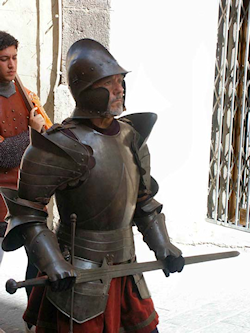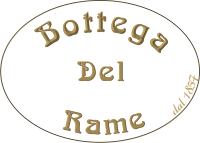The Bravìo delle Botti

The Bravìo delle Botti in Montepulciano which takes place on the last Sunday of August dates back to the 14th century.
At that time, Montepulciano's people used to organize a horse race among the many events that served to attract people from the nearby villages. This event was in conjunction with the great yearly fair that took place in August along with the feast celebrating Montepulciano's patron, Saint John – defined as decollato that means "beheaded".
Anybody could join the race, even the foreigner who, on horseback, competed for the prize that was a scarlet cloth, the so called Bravìo. A simple piece of cloth, indeed, but imbued with the smell of victory!
Some documents, dating back to the mid-fourteenth century, describe in detail the purpose and the rules of this competition. They also describe the prize and the 5 km long route.
Towards the end of the 15th century, the Bravìo was banned on grounds of public order and forgotten for a long time.
It was only in the '70s of the last century that the ancient tradition was brought back by the passionate don Marcello del Balio, vicar of Montepulciano, who prematurely died in 1981.
Don Marcello was an enthusiastic scholar of the history of his hometown who proposed with great intelligence and foresight the restoration of this territory tradition. Not only did he propose the Bravìo as a tourist attraction, he also changed it exploiting the traditional division on the town in "contrade" (districts).
He also decided to replace the horses with the barrels, – botti – either for security reasons and to give prominence to one of the main activities in Moltepulciano, the wine production.
The "Bravìo delle Botti" involves all the people of Montepulciano, for several months: from the inauguration of the Year of the "Contrade", that is celebrated on occasion of the feast of Saint Agnes, until the actual competition that takes place on the penultimate Sunday of August.
All the "Contrade" prepare the competition very carefully and all the people of the contrade, with no distinction of age, are deeply committed to make a good impression: the flag-wavers, the drummers, the walkers-on and, last but not least, the barrel pushers, the so called spingitori.
The organization of the event is also characterised by the precious and constant effort of those who work "behind the scenes" preparing costumes, choreographies, and the welcoming activities addressing the contrade hosts.
The actual race represents the end and the climax of a series of events that sees the various contrade engaged in a competition where power, resistance, dexterity and strategy are combined all together.
The search for victory starts with the street ornaments and continues with the many joyful and spectacular events that take place in the contrade were tourists are the most welcome guests.
The race, nowadays, consist of pushing a large barrels uphill for about 1,2 miles (2 km) along the steep streets of the town.
It is a challenge that involves all the possible power and dexterity from the spingitori's but, on the other hand, it takes place in a rather peaceful climate of antagonism amongst the various contrade. Unlike what you can think, the feeling of belonging to a contrada lasts all the year round.
It is a way to be part of a group and to socialize.
The occasions to meeting friends in the contrada are the most various. But each meeting has the smell of the fields to which Moltepulciano owes so much.
During the Bravìo week and even before it, the whole town is in full swing. All the streets and windows display the banners or the colour of the contrada. Every single citizen, young or old, feels directly involved in the organisation of the event or in its celebration.
Every contrada sets up shows, lunches and dinners. The challenge also consists of offering the best products or the best prepared products in the wait for the various events. In a few words, Montepulciano is celebrating!
The morning of the feast, the Contrade gather in Piazza Grande – the main town square – waiting for the raffle which establishes the order for the parade and the first who starts the competition.
The following ceremonies are the waving of the banners and the marking of the barrels.
The Holy Mass begins at 12 a.m., during the rite the Bishop blesses the Contrade, the pushers and the barrels.
The people of Montepulciano, then, go back to their houses to have lunch and to prepare themselves waiting for the afternoon when the long Historical Parade along the town street takes place. It is probably one of the most intense moments of the day: an explosion of colours with characters in costume and banner wavers.
Cesare Mazzetti forges the seal that marks the barrels since the first edition of the Bravìo delle Botti.
In effect, the ritual prescribes that any contrada has a barrel chosen at random.
The barrel and the related starting position riffle are carried out in the magnificent Palazzo comunale in the presence of all the authorities and of the contrade delegates.
Once the riffle is over the "Sindaco (Mayor) della Contrada" displays the banner on the palace façade and each contrada is assigned a barrel.
This barrel has to be completely identical to all the others. Then, each barrel has to be carefully checked.
And even in this case our Cesare Mazzetti is in charge of the process.
But also we, enthusiastic spectators of the Bravìo, thought these rituals were something prepared to attract the tourists. In short, a staged experience.
But it's not! Our dear Cesare genuinely checks that the barrels are undamaged, their efficiency and dimension.
And he carries these checks out in a very meticulous way. If the barrel passes the strict controls imposed by the regulation, it can be "marked by fire".
The whole ceremony takes place on the Duomo stairs, in a square which is full of contrade people and joyful tourists.
At 7 p.m. the race starts with the enthusiastic people of Montepulciano encouraging the pushers of their Contrada to push the barrels along the arduous uphill of the town.
The winning Contrada receives the prize the panno-bravìo.
Then the celebrations in the winning Contrada begin; there's wine flowing and a festive atmosphere.
But also in the other contrade there are beautiful dinners going on; they have to get rid of the bitterness of not having won!
It's true! And this celebration may appear to you like one among the many feasts that we celebrate in Italy, but it is not.
"I wouldn't like to sound presumptuous – claims Cesare Mazzetti – but in Montepulciano it's different: This is a celebration we have restored digging into our traditions after centuries of forgetfulness. It's not for tourist only. Our sense of belonging to a contrada is a way to feel closer to each other."
We have been told that Cesare "the copper artisan" has lived his passion for the Bravìo from the very first day along with Don Marcello.
Together with a dear friend of theirs, Livio Santinelli, he forged a copper pot for his Contrada which, during the feast night contains about 550 lb (225 kg) of polenta with ragout and this latter is "solemnly" prepared by the Contrada housewives.
The last touch during the celebration is a pasta dish, penne alla disperata. An exquisite dish which recipe remains a well kept secret of Margherita Vivarelli.
Today, Montepulciano is one of the best tourist destinations in Italy and most of this success is due to the attention that the people of Montepulciano pay to make this town lively and welcoming.
Much of this success is also due to that vicar who contributed to create the very peculiar tourist-oriented identity of this town.
Thank you don Marcello.

